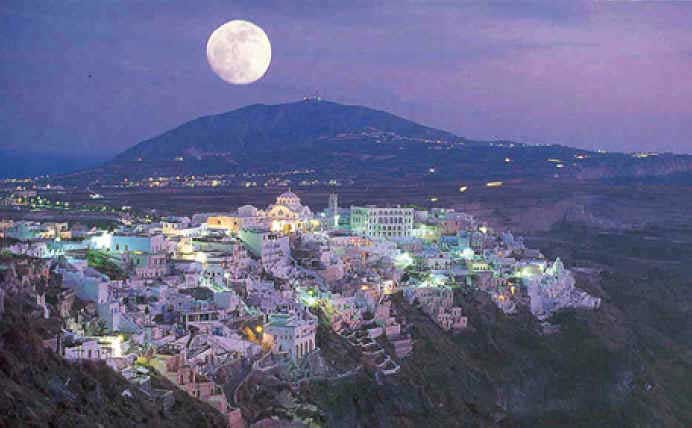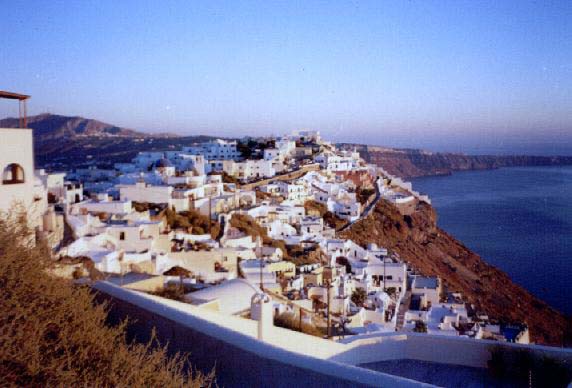
| Santorini Villages | ||||||||||||||||||||||||||
√ Santorini history |
Santorini: year 1956 the last eruption of the volcano destroyed great part of Imerovigli village
|
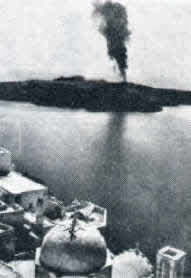 |
Santorini, an island of Cyclades, is an Aegean volcanic island arc (75,79 sq. km;
11400 inhab.) surfaced in the prehistoric age. The wide half moon shape bay (called "Caldera") is facing a group of small volcanic islands coming from the lava flow after it had solidified. These islands are: Thirassia, Aspronesi, Mikrà Kameni, Palea Kameni and Nea Kameni. These islands surfaced after the well-known eruptions of 97 BC, 1570 AD, 1707 AD, 1866 AD and 1925 AD. Excavations in the Akrotiri area have demonstrated that this island was the cradle of an advanced civilization, since 4000 years BC, destroyed by the explosion of the Volcano. In the antiquity, the Minoans inhabited the island first. Later, during the Dorian time, in the seventh century BC, the famous Cyrene (Thera's colony) was founded. In the village of Akrotiri, it has been discovered an ancient Minoian village buried under the ash of the Volcano eruption occurred 3500 years ago. The excavations highlighted many important rests, such as: public streets, buildings, a seventh-century temple of Apollo (partially built in the rock), a school, the Agora (an open "place of assembly"), a Basilica dating back to the Hellenistic Age and restored during the Roman Age. It has been also discovered a ceramic coming from the Doric Art and some archaic coins. Most of the outstanding paintings and frescos decoring the walls of private houses, are now preserved in the National Archaeological Museum of Athens. The earthquake destroyed and buried not only buildings, but an entire age. Santorini is not just an island, it didn't live and develop like all other nearby islands. It's history, inhabitants, activities, were buried deep into the earth and then revived ... not just one time! Once a time, in the place of Santorini, there were 3 small islands with no importance. Later, these islands were incorporated into Santorini:
This was the island of Santorini thousands of years ago, when its inhabitants used to call it "Stronghylì", that is "Round". After the catastrophic eruption, the peace and quiet return. First the population then the Volcano restarted, step by step, the normal activity. In 1300 BC, Phoenician ships arrived to the island and named it "Kallisti", later, in 1115 BC, it was the turn of the Dorians from Sparta to get off. They named the island as their king: Thira. Afterwards the island of Thira league with Sparta and Athens, becoming the most important Tolomei's naval base. In the third Century, during the Byzantine age, Santorini became first Chrisitian and then it was elected as the new Episcopal center. When the Francs arrived in Thira in 1204 AD the island was named Santorini and The Fortress of Skaros was appointed main town. Hereafter, the island entered a long period of struggles: Byzantine struggles, Turkish raids, competitions between Genoa and Venice (called "La Serenissima") ... until the 1579, year in which the island was annexed to the Ottoman Empire. When the war of Candia bursted, the Venetians, masters of the sea, imprisoned all Turks on the Aegean island, preventing Ottomans to settle in Santorini. Actually Turks never colonized the island, so Santorini enjoyed a partial autonomy and a self–government. Inhabitants elected their representatives (called "Gerontes") who had to deal with Ottoman and Venetian autorities. Infact, the island was obliged to pay taxes to both the Sultan and the Republic of Venice. Nowadays, the main town, Thira or Firà, is represented worldwide by its white-washed homes interspersed with Byzantine churches with sky-blue domes (there is also a catholic church in Firostefani), numerous shops selling everything from jewels to artwork, from souvlaki to local wines, ... clinging to the rim of the caldera nine hundred feet above the old port. The particularity of the town is its white cobblestone pedestrian alleys bustle with tavernas, hotels and cafes. These features are common to other villages: Imerovigli, Firostefani, Pyrgos and, especially, Oia. |
One of the most ancient images of the center, dating back to the beginning of the last century
|
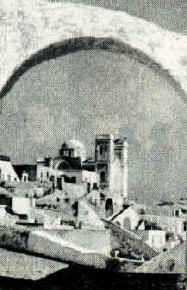 |
|
The Volcano in 1926
|
 |
|
The village of Thira in the late 80s |
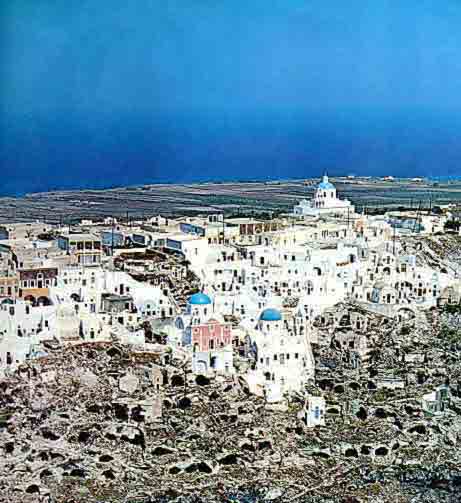 |
|
Santorini by Night |
||
View of Thira from Imerovigli |
||
The Volcano - today
|
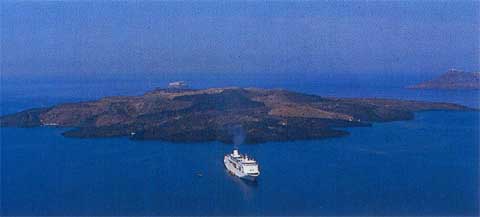 |
about us | site map | advertising | contacts | disclaimer | links |
